#zofia stryjenska
Text
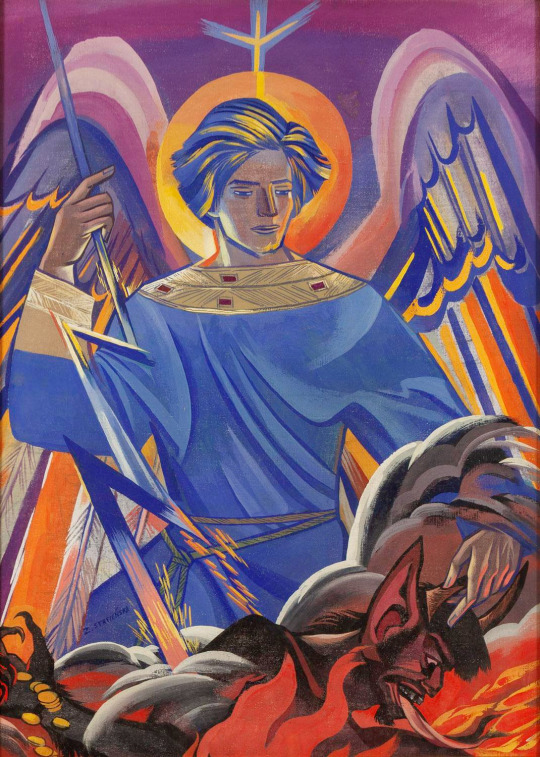
Archangel Michael fighting Satan by Zofia Stryjeńska (Polish, 1891-1976)
#art deco#art#polish art#catholic art#christian art#poland#zofia stryjeńska#zofia stryjenska#archangel michael#roman catholic#catholicism#catholic#roman catholicism#christian#christianity#angel#painting#polish painters#female artist#female painter#*
360 notes
·
View notes
Text

Zofia Stryjenska - Kąpiące się nimfy i satyr
6 notes
·
View notes
Text

Pory roku. Listopad-Grudzień. (Season. November-December) by Zofia Stryjeńska (polish) 1925 s
#polish#painting#art#seasons#pageant#Zofia Stryjenska#Zofia Stryjeńska#1920s#1925#tempera#woman artist#slavic
26 notes
·
View notes
Text

Zofia Stryjeńska (PL, 1891-1976) [Puszczanie wianków na Wiśle] 1950/52
Tempera, Canvas glued on Cardboard, 71.5 x 90.5cm
@art.by.women_women.in.arts
Middsummer Polish tradition of offering Flower Crowns to the River
#KupalaNight is a traditional Slavic holiday that was originally celebrated on the shortest night of the year, which is on 21-22 or 23-24 of June (Czech Republic, Poland, and Slovakia and according to Julian calendar on the night between 6 and 7 July (Ukraine, Belarus and Russia). Calendar-wise, it is opposite to the winter holiday Koliada.
The celebration relates to the #summersolstice when nights are the shortest and includes a number of Slavic rituals. It involves herb collecting, bonfire lighting, and bathing in the river. via Wikipedia
#sztukakobiet #PalianShow @abwwia #ZofiaStryjeńska #womensart #midsummer #PolisHArt #summersolstice #nockupały @folkmania
4 notes
·
View notes
Text
"Z rodzinnego domu wyniosła przyszła malarka system wartości i zasady, jakimi kierowała się potem w swoim życiu. Zawsze mogła liczyć na rodzinę - na ojca i matkę, do której do końca jej życia pisywała czułe listy i takież otrzymywała. Miała też oparcie w rodzeństwie. Była, podobnie jak matka, głęboko wierząca. Po latach bardzo ubolewała, gdy jej dzieci brały śluby cywilne - bojkotowała je. Z zapisków na książeczce do modlitwy wiemy, że będąc na emigracji i ciągle cierpiąc brak pieniędzy, zamawiała "msze śpiewane" w intencji Jana Matejki, którym była zachwycona, modliła się także za Rembrandta, Mickiewicza, Skłodowską-Curie, Kopernika, Wyspiańskiego, Moniuszkę, Chopina, Sienkiewicza, Paderewskiego, o "nawrócenie własne", a także... wróżki i wierzycieli (stale miała jakieś długi). Jednocześnie nigdy nie była suchą dewotką - pełna temperamentu, przed zamążpójściem lubiła flirtować, bywała na potańcówkach. Kiedy wszakże wychodziła za mąż za Stryjeńskiego, była dziewicą."
Kulturalne Ingrediencje, o Zofii Stryjeńskiej
#zofia stryjeńska#zofia stryjenska#stryjeńska#polska#po polsku#poland#polskie cytaty#polski blog#cytaty#cytaty po polsku#bóg#chopin#maria skłodowska curie#stanisław wyspiański#moniuszko#henryk sienkiewicz#ignacy jan paderewski#mikołaj kopernik#jan matejko#adam mickiewicz
23 notes
·
View notes
Text

Zofia Stryjeńska, Tańce Polskie (Polish dances)
XX w. oil on canvas,
In 1911, posing as a man, Zofia enrolled to Munich Academy of Fine Arts. After a year as her gender was exposed, she was forced to leave the academy. Nonetheless, Zofia Stryjeńskia managed to gain recognision and popularity as an artist. Characteristic to her art were the motives and topics of Polish and slavonic folklore and culture.
#poland#polish culture#polish art#polish painters#polish paintings#european art#european paintings#european painters#zofia stryjeńska#stryjenska
3 notes
·
View notes
Text
Witcher Slash Fic Rec - Wiosna

Wiosna by eldritcher
Pairing - Geralt/Emhyr. Rating - M. 50000 words.
Canon blind reading - I don't feel this is going to make sense without canon understanding.
Rec because - If you are done with winter already and need some spring in your life this is for you! I don't know how a fic can feel like a season. But this one definitely has that. It's got a joyful happy ending. It's a really joyful fic. Not fluffy, pretty dark and intense. But really joyful. Ends with a kiteflying competition! <3
Something really unique in my opinion is the cultural vibe. It feels grounded in the same cultural vibe of the canon. Even the prose feels like it's got that vibe. Dark, melancholy, evocative, hopeful.
Beautiful hurt/comfort old school slash fic. Midlife crisis emotionally messed up dudes. No big plot. 100% characterization and interiority focus. The pacing is gentle and it gets the feelings to soak. Like slowcooker chicken soup if slowcooker chicken soup has got lots and lots of smut.
The smut is really hot and also we get a lot of it. Complicated power dynamics. The relationship arc is beautiful.
Not really bombastic. No high drama or big moments. But it's got a sneaky undercurrent with really dark folklore which gets resolved and feels like the winter to spring transition.
Geralt's characterization feels true to Canon Geralt. Really other, really jaded, really cautious but also hopeful. Same for Ciri. Emhyr's characterization is brilliant. He is messed up and messy is fun in fic.
Two big relationship arcs. Geralt/Emhyr is the romance. Ciri's reconcilation with Emhyr is the platonic side. It's not really a fixit because nothing gets fixed which makes sense for this canon. I don't know how to explain. But I feel the intricacy/nuance made the relationship arcs more beautiful in this case.
It gets the twisted Rumpelstiltskin type canon vibe with a happy ending.
Getting a Vibe Quote is super hard because it's a flowing fic and hard to excerpt. But it's great. Trust me! <3
art source Mazur by Zofia Stryjenska, Joys of Spring by Rene Lelong
#the witcher#witcher slash fic#slash fic recs#long fic recs#longfic slash recs#geralt x emhyr#emralt#emhyr & ciri#emhyr/geralt#wiosna
2 notes
·
View notes
Photo

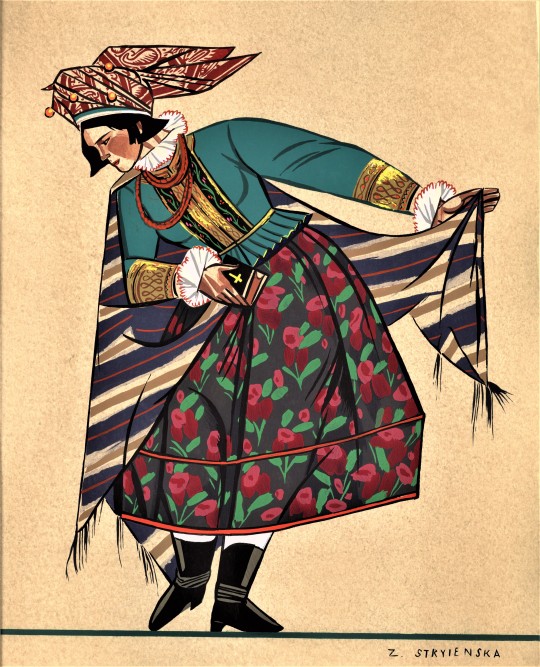


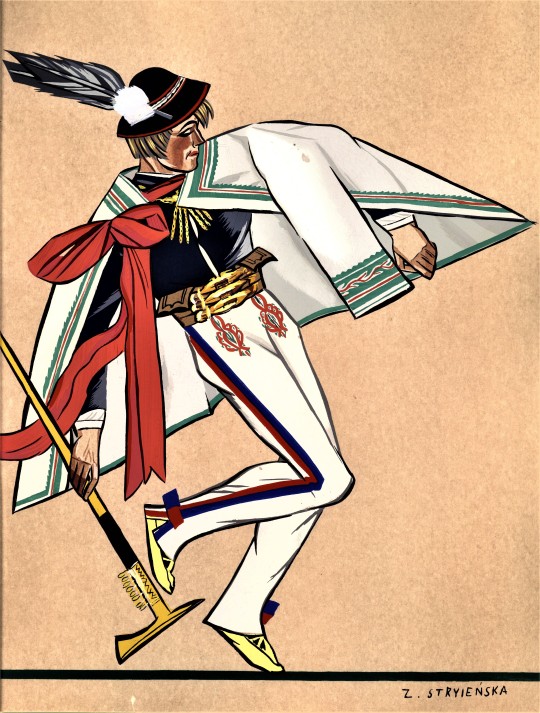

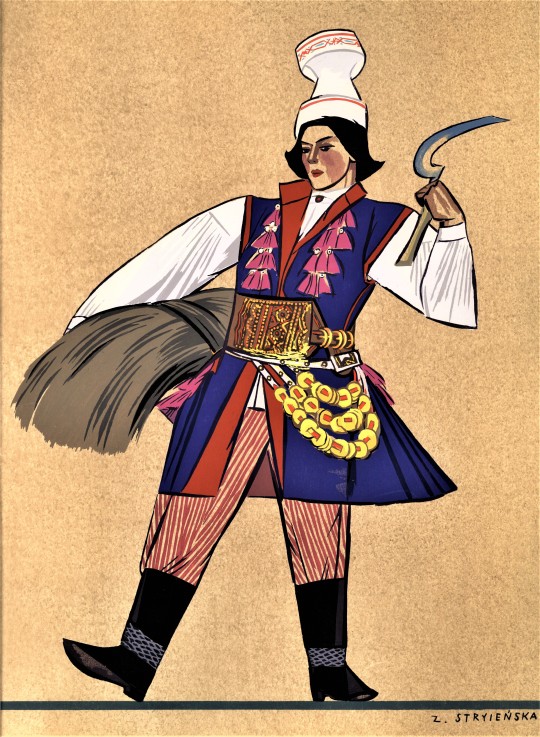

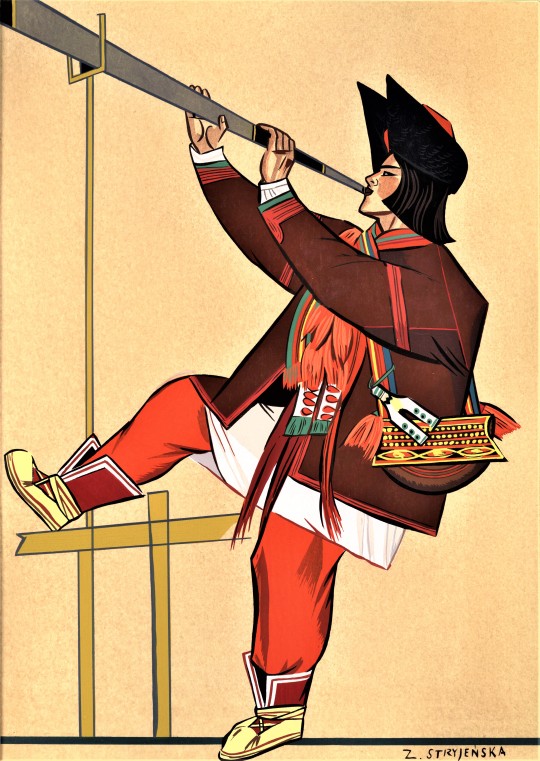
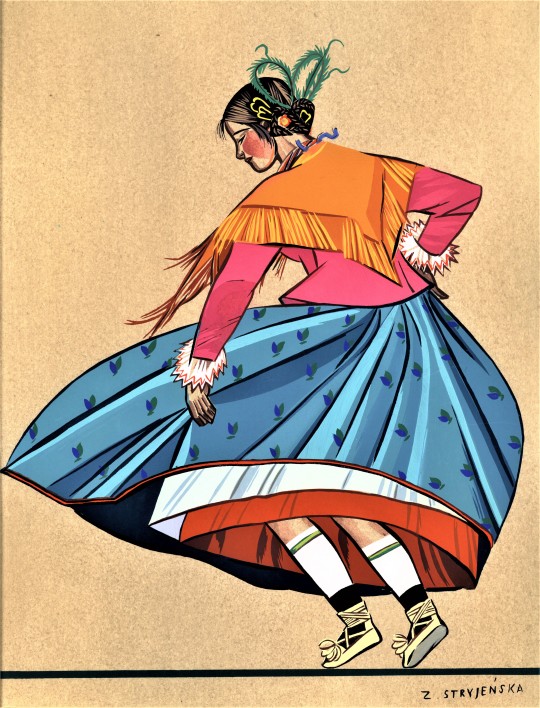
Another Folk Fashion Friday!
This week we have another great set of plates featuring folk costume, this time from Poland. Polish Peasant Costumes, published in 1939 by C. Szwedzicki in Nice, France, in an edition of 400 copies signed by the publisher, features 40 pochoir plates of paintings by Polish artist Zofia Stryjeńska. One of the most influential Polish women artists of the interwar period, Stryjeńska learned her craft at the Academy of Fine Arts in Munich, where she enrolled as a man to circumvent the proscription on women students. Stryjeńska’s works mostly utilized the tempura technique, often combining Polish folk iconography with Christian religious motif.
Very little is known about the publisher, C. Szwedzicki, including their first name. What is known is that they operated a fine arts press out of Nice, France. Szwedzicki became known to an international audience in 1929, when they published the portfolio, Kiowa Indian Art, commissioned by Swedish-American painter and curator Oscar Jacobson. Szwedzicki produced 6 volumes of Native American Art with Jacobson, but work on these volumes was interrupted when his business was seized, either by German Nazis or French Pétainists, and Szwedzicki was shipped off to Poland. Szwedzicki survived and Jacobson, with some difficulty, located him in Nice after the war as Szwedzicki worked to rebuild his business.
Polish Peasant Costumes and the 6 portfolios of Native American art produced for Jacobson are the only extant works known to be produced by this publisher, but the skill of the printing indicates a larger body a work that has likely been lost to the ravages of WWII and the march of time. Printed in 1939, Polish Peasant Costumes would have been published prior to Szwedzicki’s internment in Poland.
Included is an introduction and descriptions of the plates in English and French by Polish artist, museologist, and researcher of folk art Seweryn Tadeusz. He writes, “The costume is a child of the soil, for it is the outgrowth of the crops that are raised, of the beasts that are bred and of the means whereby raw materials are worked. Hence, it forms a part of the landscape.”
Included here, in order, are:
1. A Volhynian bride, with a headdress of woolen pompoms and tinsel from which flows a cascade of ribbon.
2. A Cracovian peasant woman with typical jerkin.
3. A Silesian peasant with the best man’s wedding wand.
4. Kasubian fisherwoman in her festive pleated bonnet.
5. A “goral,” or highlander, of the Tatra mountains.
6. A peasant woman from the Kurpie region.
7. A Cracovian farm lad with woolen bonnet.
8. A Lowicz woman in wedding wreath. The stripped cloth is characteristic of both men and women’s dress, with each neighboring village presenting a unique arrangement and color striping.
9. A Hutsul peasant from the highlands near Vorochta, blowing his long wooden trumpet.
10. A dancing highland girl.
Check out our past Fashion Friday posts. Shout out to our UWM undergrad student who stopped by the reading room to view this portfolio for a research project. If you are local to Milwaukee, come on by, we love taking your reference requests!
-Olivia, Special Collections Graduate Intern
#fashion friday#folkfashion#folk costumes#Polish Peasant Costumes#poland#polish folk costumes#zofia stryjenska#c. szwedzicki#pochoir#Seweryn Tadeusz#Oscar Jacobson#olivia
947 notes
·
View notes
Photo

“Folk costume from Silesia” (1939) by by Zofia Stryjenska (Polish;1891 - 1976), pochoir coloured by gouache on paper; private collection
DESA UNICUM
#Zofia Stryjenska#zofia stryjeńska#stryjenska#stryjeńska#art#artist#painter#art deco#poland#folklore#folkart#polish art#polish artist#Polish painters#Polish Painter
33 notes
·
View notes
Text

Motherhood by Zofia Stryjeńska (Polish, 1891-1976)
#motherhood#zofia stryjeńska#zofia stryjenska#polish art#poland#folklore#painting#polish painters#polish painting#polish painter#cottagecore#cottage#countryside#countrycore#polish countryside#art deco#slavic#polska#women in art#female artist#family#*
61 notes
·
View notes
Text
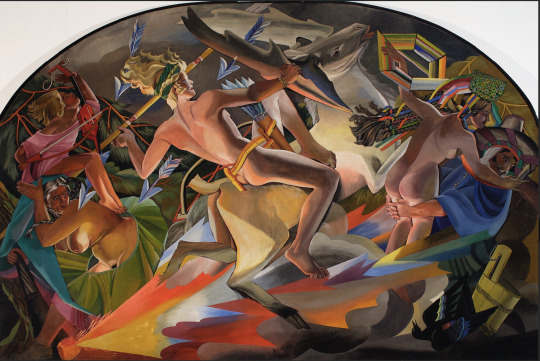
ogień (fire) by Zofia Stryjeńska (polish)
11 notes
·
View notes
Text
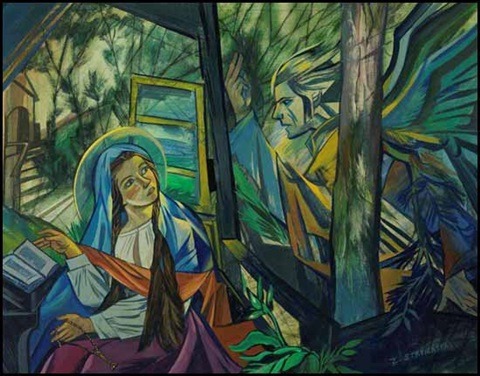
Zofia Stryjenska, Annunciation
9 notes
·
View notes
Text
"Tymczasem coś źle się czułam, prof. Rosner bada mnie i oznajmia, że jestem w ciąży. Szaleję z radości! Zawsze pragnęłam mieć syna, który by wyśpiewywał poezję Słowiańszczyzny. I będzie torował drogę idei słowiańskiej – Odbudujemy gontyny – będziemy wielbić Chrystusa po słowiańsku!"
— Zofia Stryjeńska
#zofia stryjeńska#zofia stryjenska#malarstwo#cytaty po polsku#polskie cytaty#cytaty#polski cytat#ciąża#polska#poland#po polsku#polski blog#polski tumblr#młoda polska#słowianie#słowianka#słowianin#catholic poland#kościół#slavic
20 notes
·
View notes
Text
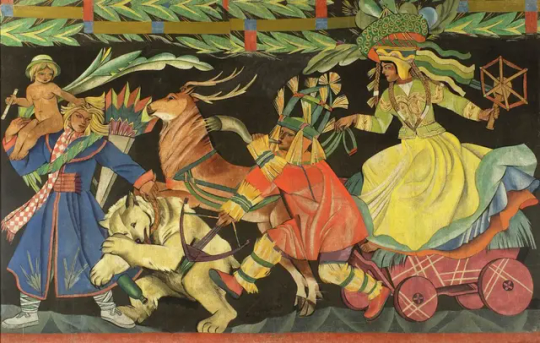
Zofia Stryjeńska,
z cyklu Korowód miesięcy słowiańskich - Pory roku. Listopad-grudzień (Korowód I - z jeleniem)
[from the cycle Procession of Slavonic Months - Season of the year. November - December (Procession I with the dear)]
ca. 1925
picture used on the basis of citation right
#poland#polish culture#polish art#polish paintings#polish painters#european art#european paintings#european fine art#polska#zofia stryjeńska#stryjenska#slavic#slavic folklore#slavonic
2 notes
·
View notes

